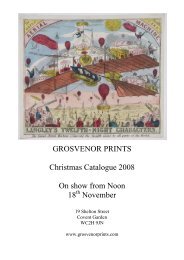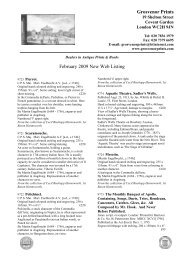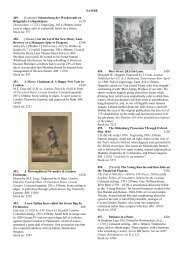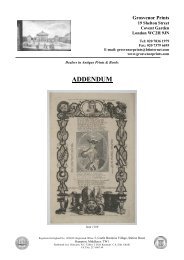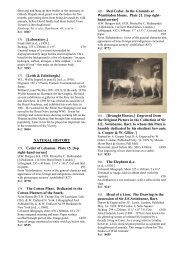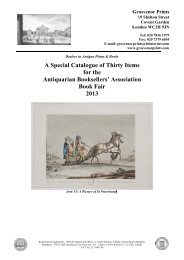06 London.pdf - Grosvenor Prints
06 London.pdf - Grosvenor Prints
06 London.pdf - Grosvenor Prints
You also want an ePaper? Increase the reach of your titles
YUMPU automatically turns print PDFs into web optimized ePapers that Google loves.
the whirling round, in which Exercise nonecan equal these Zealots. II.de Partie.Quand le Predicateur a fini son Discours,et tandis que son Compagnon est assis surle Plancher avec lui, les Dervis changeantleur Habillement en un Veste courte & unelongue Jupe, se mettent a tourner sur euxmêmesde la maniere representée; au Sond’une Musique lugubre; puis s’arretent &recommencent à tourner, Personne nesauroit égaler ces Zélotes dans cet Exercise.Pl. XX.R Dalton delt. et fecit. [n.d. c.1700.]Engraving. Plate 269 x 422mm. 10⅝" x 16⅝". £220The Ottoman Sultan and his assistant watch as hisSubjects spiritually dance.Ex: Oettingen-Wallerstein collection.Ref: 9251229. Prince William offering his sword tothe Dean, at the Altar, the KnightsStanding under their Banners.J. Highmore del: J. Pine Sculpt. [n.d., c.1770.]Etching and engraving, 445 x 610mm. 17¾ x 24".Vertical centrefold as issued. Small chips and tears intoimage from extremities. £360Ceremony of installation of knights of the Order of theBath inside Westminster Abbey. A young PrinceWilliam, Duke of Cumberland (1721 – 1765), ayounger son of George II, kneels before the altar. Theknights stand in plumed hats in rows at either sideunder their banners, a huge crowd of spectators beyondthe altar.The Most Honourable Order of the Bath is an order ofchivalry founded by George I on 18 May 1725. Thename derives from the medieval ceremony for creatinga knight, which involved bathing (as a symbol ofpurification) as one of its elements. Recipients of theOrder are now usually senior military officers or seniorcivil servants.The Order of the Bath is the fourth-most senior of theBritish Orders of Chivalry, after The Most Noble Orderof the Garter, The Most Ancient and Most Noble Orderof the Thistle, and The Most Illustrious Order of StPatrick.Numbered 'III' upper left, this is a plate to 'Theprocession and ceremonies observed at the time of theInstallation of the Knights Companion of the Order ofthe Bath', <strong>London</strong>; J. Pine, first published 1730. JohnPine (1690 - 1756), engraver, publisher, print andmapseller, was Bluemantle pursuivant at the College ofArms and engraver to the king's signet and stampoffice.Very scarce.Ref: 9099230. The Paris Militia setting out forVersailles on the 5th. of October 1789.Départ de la Milice Bourgeoise pourVersailles le 5 Octobre 1789.Drawn on the Spot by an eminent Artist. Designé sur leLieu par un Amateur distingué. [J. Wells aquatinta.]<strong>London</strong> Publish'd Nov. 24. 1789. by B. Vander GuchtLower Brook Street.& J.White Tavistock Street. ALondres chez B. Vander Gucht et I. White Nov. 241789.Aquatint. Plate 318 x 603mm. 12½" x 23¾". Very fine.£480Ex: Oettingen-Wallerstein collection.Ref: 9209231. The Taking of the Bastille on the 14of July 1789. Prise de la Bastille, le 14Juillet 1789.Drawn on the Spot by an eminent Artist. Designé sur leLieu par un Amateur distingué. J. Wells aquatinta.<strong>London</strong> Publish'd Nov. 20. 1789. by B. Vander GuchtLower Brook Street.& J.White Tavistock Street. ALondres chez B. Vander Gucht & J. White.Aquatint. Plate 375 x 501mm. 14¾" x 19¾". Very fine.£480Ex: Oettingen-Wallerstein collection.Ref: 9208LONDON232. The <strong>London</strong> Fish Market AtBillingsgate. Erected By The CorporationOf The City Of <strong>London</strong>.Chromolithographed By C.F. Kell, 8 Castle St.Holborn, E.C [n.d., 1877].Chromolithograph trimmed to image and laid onpublisher's card as issued, image 295 x 650mm. 11¾ x25½". Card trimmed/damaged. Missing some of thetext below image. £450View of Billingsgate market from the river. In 1849,the famous <strong>London</strong> fish market was moved off thestreets into its own riverside building, which wasdemolished c. 1873 and replaced by this arcadedmarket hall. It was designed by City architect SirHorace Jones and built by John Mowlem & Co. in1875. This building, known as Old BillingsgateMarket, is now used as a corporate events venue.Guildhall Library Record: 21750.Ref: 8814
233. Part of the Bridge at Blackfriars. Asit was in July 1766.Edw.d Rooker delin et Sculp. Publish'd Accordijng toAct of Parliament by Edward Rooker, December the 311766.Engraving. 420 x 660mm. 16½ x 26". Mint. £850The first Blackfriars Bridge, built by Robert Milnefrom Portland stone, opening 1769.Ref: 9089234. Red Lyon Square.[n.d., c.1750.]Engraving. 165 x 245mm, 6½ x 8½". Tears in margins.£90Red Lion Square in Bloomsbury, named after the localinn. Laid out in 1698, it was described by Hatton in1708 as 'a pleasant square of good buildings, betweenHigh Holborn south and the fields north'. According tolegend the bodies of Oliver Cromwell and two otherregicides had been placed in a pit on the site of thesquare.Ref: 9233235. The Royal Military Asylum AtChelsea. For Soldiers Children of theRegular Army__Intended for 500 Girls &500 Boys.Published 20th. May, 1805, by Laurie & Whittle,No.53, Fleet Street, <strong>London</strong>.Etching and engraving coloured by hand, image 260 x405mm. 10¼ x 17¾". Trimmed to plate at top. Tearthrough title. £220View of the Royal Military Asylum, (Duke of York'sRoyal Military School) Chelsea, with soldiers, womenand children outside. The Asylum was opened as aschool for the children of soldiers. It is now the Dukeof York's Barracks.Ref: 8737236. A View of Chelsea Water Works. ~J. Boydell del & Sculp. Publish'd according to Act ofParliament by J. Boydell Engraver at the Unicorn theCorner of Queen Street, Cheapside. <strong>London</strong> 1752.Price 1s.Engraving. 430 x 260mm. Trimmed to plate and tippedinto album page. Vertical centre crease from fold. Astrong impression. £180The Chelsea Waterworks Company was formed in1723 and supplied water to Westminster and adjacentparts. It introduced the first iron main in <strong>London</strong> in1746. The company held water in reservoirs in HydePark and Green Park and pumped water through anelaborate sysstems of canals which covered a large areaof today's Pimlico. As the years marched by the waterwas becoming more and more contaminated and theCompany installed the first Sand filtration operation topurify the water. Eventurally in the late nineteenthcentury the company became part of the MetropolitanWater Board. Numbered 'No.5' lower right.This was reprinted in Boydell's "A collection of onehundred views in England and Wales" in 1770.Ref: 8739237. A Perspective View of CoventGarden. Vue de Covent Garden.Printed for Robert Wilkinson in Cornhil. & CaringtonBowles in St. Paul's Church Yard, <strong>London</strong> [n.d.,c.1750].Engraving and etching with hand colour, 250 x425mm. 9¾ x 16¾". Marginal staining. £450View of the piazza towards St Paul's church, with themarket in progress.Ref: 8755238. Crinoline 1858. Cremorne.T.H. Guerin [in image lower right]. Published by T.Archer [damage] Mortimer Street, Regent Street.Sepia tinted lithograph with colour added by hand,sheet 345 x 435mm. 13½ x 17". Creases; tear intopublication line. £180A satire on mid 19th century female fashion set inCremorne Gardens, once a popular pleasure gardens bythe side of the River Thames in Chelsea. A woman in ahuge dress descends from a carriage, the driver aboveensuring that his reins are well out of the way.Crinoline was originally a stiff fabric with a weft ofhorse-hair and a warp of cotton or linen thread. Thefabric first appeared around 1830, but by 1850 theword had come to mean a stiffened petticoat or rigidskirt-shaped structure of steel designed to support theskirts of a woman’s dress in the required shape. Thecrinoline was the subject of much ridicule and satire,particularly in Punch magazine. Dress reformers didnot like it either — they seized upon the cage aspect ofthe crinoline and claimed that it effectively imprisonedwomen. Given that the crinoline did eventually have amaximum diameter of up to 180 centimetres (six feet),it is easy to imagine difficulties in getting throughdoors, in and out of carriages, and the general problemsof moving in such a large structure. The secondproblem was the potential impropriety of the crinoline.Its lightness was a curse as well as a blessing, as a gustof wind or a knock could set it swinging and reveal thewearer's legs. Even worse, if a woman tripped or wasknocked over, the crinoline would hold her skirts up.Ref: 8997239. Crinoline 1858. Belgravia.T.H. Guerin. Del [in image lower left.] [<strong>London</strong>, T.Archer.]Sepia tinted lithograph with colour added by hand,sheet 315 x 415mm. 12½ x 16¼". Trimmed to imagetop and sides. £180A satire on mid 19th century female fashion. A womanin a huge dress rather awkwardly descends from a
carriage. Crinoline was originally a stiff fabric with aweft of horse-hair and a warp of cotton or linen thread.The fabric first appeared around 1830, but by 1850 theword had come to mean a stiffened petticoat or rigidskirt-shaped structure of steel designed to support theskirts of a woman’s dress in the required shape. Thecrinoline was the subject of much ridicule and satire,particularly in Punch magazine. Dress reformers didnot like it either — they seized upon the cage aspect ofthe crinoline and claimed that it effectively imprisonedwomen. Given that the crinoline did eventually have amaximum diameter of up to 180 centimetres (six feet),it is easy to imagine difficulties in getting throughdoors, in and out of carriages, and the general problemsof moving in such a large structure. The secondproblem was the potential impropriety of the crinoline.Its lightness was a curse as well as a blessing, as a gustof wind or a knock could set it swinging and reveal thewearer's legs. Even worse, if a woman tripped or wasknocked over, the crinoline would hold her skirts up.Ref: 8996240. Crinoline 1858. Brompton.[T.H. Guerin.] [<strong>London</strong>, T. Archer.]Sepia tinted lithograph with colour added by hand,sheet 300 x 405mm. 11¾ x 16". Trimmed to image topand sides. £180A satire on mid 19th century female fashion. A malepassenger enjoys the view as a female carriage driver'sskirt is blown upwards. Crinoline was originally a stifffabric with a weft of horse-hair and a warp of cotton orlinen thread. The fabric first appeared around 1830, butby 1850 the word had come to mean a stiffenedpetticoat or rigid skirt-shaped structure of steeldesigned to support the skirts of a woman’s dress in therequired shape. The crinoline was the subject of muchridicule and satire, particularly in Punch magazine.Dress reformers did not like it either — they seizedupon the cage aspect of the crinoline and claimed thatit effectively imprisoned women. Given that thecrinoline did eventually have a maximum diameter ofup to 180 centimetres (six feet), it is easy to imaginedifficulties in getting through doors, in and out ofcarriages, and the general problems of moving in sucha large structure. The second problem was the potentialimpropriety of the crinoline. Its lightness was a curseas well as a blessing, as a gust of wind or a knockcould set it swinging and reveal the wearer's legs. Evenworse, if a woman tripped or was knocked over, thecrinoline would hold her skirts up.Ref: 8993241. [The Thames and the Embankmentlooking east, with a view of St. Paul's.]Rowland Langmaid [signed in pencil lower right.] [n.d.c.1920.]Etching. 295 x 230mm. 11½ x 9". £320A pupil of W L Wyllie, Rowland Langmaid (1897 -1956) served in the Royal Navy; He exhibited at theR.A.'Proof' blindstamp lower left.Ref: 8629242. The Tower & Preparation of the FireWorks, with the Balloon, In the ParkAug.t. 1st. 1814.J.H. Clark Del. M. Dubourg Sculpt. Published & SoldAug.t 12.th 1814 by EDW.D ORME, Publisher to hisMajesty and H.R.H. the Prince Regent, Bond Street,/corner of Brook Str./ <strong>London</strong>Coloured aquatint, print area 200 x 290mm. £120On Monday, August 1st 1814, a national jubilee tookplace to celebrate the return of peace. In the early partof the evening James Sadler, the first Englishballoonist, ascended in his balloon from the space infront of Buckingham House, after which a two hourfirework display took place in Green Park.Ref: 8193243. St. Bride's Avenue. TheImprovement in Fleet Street, Proposed ToBe Erected By Voluntary Subscription,1825. The Committee [a list of members'names follows in three columns below].The Public are respectfully informed thatthe Work is commenced and will becompleted with all convenient speed. EarlyContributions are requested in support ofan Improvement so conducive to thegeneral Embellishment of the Metropolis.John B. Papworth, Archt. Thos. Kearnan, Sculpt.Published by R. Ackermann, 101, Strand, Jany. 28th.1825.Engraving, outline proof with open letters, 505 x330mm. £260View of St Brides Avenue as seen from fleet street,with figures and adjacent shop fronts, including thepremises of Pitman and Ashfield to the left.John Buonarroti Papworth (1775 - 1847), architect anddesigner, was a thorough master of drawingperspective and classic ornament. Many of hisarchitectural designs were exhibited at the RoyalAcademy yearly from 1794 to 1799. For the premisesof Rudolf Ackermann, the publisher of this engraving,to whose ‘Repository of Arts and Essays’ from 1809 to1823 he was a frequent contributor of prose and verseand of drawings, he designed a hall or reception-room,intended as a lounge for customers. In 1826 he workedon the extensive building, No. 96 Strand, at the corner
of Beaufort Buildings, now occupied by Rimmel theperfumer.His most important architectural work in <strong>London</strong> ishere represented - St. Bride's Avenue, Fleet Street. Thisprovided a clear view and a good access for themagnificent steeple of St. Bride's Church, previouslyscreened from Fleet Street by a row of houses. Thisvision of how the new street might look is intended toencourage subscriptions for the project. The details ofwhere subscriptions were received are provided to theleft and right of the caption below the image.Guildhall Library Record: 1693. Also two colouredimpressions.Ref: 8758244. Fleet Street & St Paul's <strong>London</strong>[pencil, lower left.]Henry Lambert [signed in pencil lower right.] [n.d.,c.1950.]Etching with watercolour, 185 x 150mm. 7¼ x 6". £80A lively view of Fleet Street looking towards St. Paul'sCathedral by Terrence Henry Lambert b.1891.Ref: 8805245. [The Houses of Parliament from theThames.]Marcel Schuette, 1928 [signed and dated in pencillower left.]Etching, 270 x 390mm. 10½ x 15¼". Lightly stained.£220The Palace of Westminster from the river, someThames barges in the foreground.Ref: 8626246. Index to the View of <strong>London</strong>.[Lettered A-Z; and; Numbered 1-90listings of specific locations.][J. Swertner] Published as the Act directs by J.Swertner Aug.t 1.st 1789.Etching with aquatint. Plate 122 x 743mm. 4¾" x29¼". Some tearing around the platemark, with somecreasing through the image. £260Key to a view of Westminster and the City of <strong>London</strong>from Islington.Guildhall Library Print Room: p7494442.Ref: 9192247. Ironmongers Hall with a View ofFenchurch Street. L'Hotel des Ferronniersdans la Rue de Fenchurch a Londres.I.Donowell delin. T.Bowles Sculp. Publishedaccording to Act of Parliament Aug 1. 1753. <strong>London</strong>Printed for Tho. Bowles in St Pauls Church Yard, JohnBowles & Son in Cornhill, R Sayer in Fleet Street andH. Overton without Newgate.Engraving and etching, 260 x 415mm. 10¼ x 16¼".Tatty extremities. £180View of Ironmongers' Hall and Fenchurch Street with astreet scene and horse-drawn vehicles. The new hall byThomas Holden replaced the Elizabethan buildingwhich was in use until 1748.Ref: 8741248. Green House, Kensington Gardens.[old ink mss.][n.d., c.1790.]Aquatint, titled in old ink mss. 170 x 240mm, 16¾ x9½". £130Scarce.Ref: 9221249. A perspective View of the SouthFront of Kensington Palace, taken fromthe End of the Slope...Highmore junr. delin. J. Tinney Sculpsit. [n.d., c.1770.]Etching and engraving with fine original hand colour,image 310 x 470mm. 12¼ x 18½". Trimmed to imageand laid on thick paper. Title excised and glued toverso, incomplete. £360From a collection of views showing Kensington Palaceand its gardens. Probably a re-worked and re-issuedplate from the series first published 1751 by Bowlesand Sayer.Highmore, Anthony 1719-1799, draughtsman, wasdeaf, and resided principally at Canterbury, where heoccupied himself with the study of theology.John Tinney, engraver, practised both in line andmezzotint, but with no great ability, during the reign ofGeorge II. He was also a printseller, and carried onbusiness at the Golden Lion in Fleet Street, <strong>London</strong>,where all his own works were published. His mezzotintplates include portraits. He engraved in line a set often views of Hampton Court and Kensington Palace,after Anthony Highmore. Tinney is now rememberedas the master of the distinguished engravers WilliamWoollett, Anthony Walker, and John Browne. He diedin 1761.See 3187.Ref: 8807250. Londres (avec le Bourg deSouthwark) superficie 3, 900, 000 toises.Indication de Principales Rues et desPrincipaux Edifices (Principal Street andBuildings). CITY (N.B. On commence parle Sud Ouest) (N.B. On va d'abord del'Ouest a l'Est) [Numbered locations 1-80.]PARTIE OCCIDENTALE Depuis Hyde
257. New Bedlam In Morefields.Hospitium Mente Captorum Londinense.Sely fecit. [n.d., c.1770.]Etching and engraving, 415 x 570mm. 16¼ x 22½".Centrefold as issued. £360View of Old Bethlehem Hospital, Moorfields, from aplate originally engraved c. 1700. The Bethlem RoyalHospital of <strong>London</strong> (now located in Bromley, southeast <strong>London</strong>), which has been variously known as St.Mary Bethlehem, Bethlem Hospital, BethlehemHospital and Bedlam, was one of Europe's first andmost notorious psychiatric hospitals. The word Bedlamhas long been used for lunatic asylums in general, andlater for a scene of uproar and confusion. In 1815,Bedlam was moved to St George's Fields, Southwark,into buildings designed by Sydney Smirke now used tohouse the Imperial War Museum.Ref: 88<strong>06</strong>258. A view of the Canal, ChineseBuilding, Rotundo, &c. in RanelaghGardens, with the Masquerade. Vue duCanal, du Batiment, Chinois, de laRotunda, &c, des Jardins de Ranelagh unjour de Masquarade.Canalet delint. C.Grignion Sculp. Publish'd accordingto Act of Parliament. Printed for and sold by RobtSayer at the Golden Buck opposite Fetter Lane FleetStreet [n.d., c.1750].Engraving and etching with fine hand colour, sheet 265x 405mm. 10½ x 16". £170Ranelagh Gardens, adjoining Wren's ChelseaPensioner's Hospital, became popular as a place toescape the city and take in the cleaner air in Chelsea.Balls, concerts, dinners and of course gossip wereshared here almost daily. It quickly exceeded Vauxhallin popularity, but it's popularity waned until the seasonof 1804 when the fashionable set abandoned it entirely.Revellers promenade in the gardens in their ballcostumes.Ref: 8729259. Shepherd Market. Mayfair.Herbert Reeve [signed in pencil lower right.] [n.d.,c.1910.]Etching, 280 x 185mm. 11 x 7¼". £130View of this fashionable shopping street by HerbertReeve (b.1870).Ref: 8801260. View Of Old Smithfield Market, June1855.Entered at Stationer's Hall. Published by W. Hodsdon,68, St John St. Smithfield.Lithograph, image 285 x 440mm. 11¼ x 17¼".Trimmed and laid on board with excised title below.£280View of old Smithfield Market, with pigs and sheep inpens and figures, cattle and horses. The presentSmithfield meat market on Charterhouse Street wasestablished by an Act of Parliament: the 1860Metropolitan Meat and Poultry Market Act. It is a largemarket with permanent buildings, designed by Cityarchitect Sir Horace Jones, who was also responsiblefor Billingsgate and Leadenhall Markets. Meat hasbeen traded at Smithfield Market for over 800 years,making it one of the oldest markets in <strong>London</strong>. Alivestock market occupied the site as early as the 10thcentury.See Guildhall Library Record: 6893 for a colouredimpression.Ref: 8786261. Somerset House. La Maison deSomerset.L. Knyff Del. I. Kip Sculp. Printed & sold by J. Smithat ye Sign of Exeter Change in ye Strand [n.d., c.1725].Engraving and etching, 355 x 490mm. 14 x 19¼".Filled worm holes, laid on conservation backing. £240Bird's eye view of Somerset House and its garden andfountain from the Thames.This print was published in vol. I of Mortier/Smith's'Nouveau Théâtre de la Grande Bretagne' between1724 and 1729; it was plate 6 in Smith's editions, butplate 4 in Mortier's. Numbered '4' bottom right.Ref: 8723262. [Somerset House and St Paul'sCathedral from Embankment Gardens.]R.Turner [?] 1879.Pen and watercolour, signed and dated bottom right.Sheet 170 x 250mm, 6¾ x 10". A few spots. £130Also showing Cleopatra's Needle and Waterloo Bridge.Ref: 9239263. A Perspective View of the RoyalGarden of Somerset. next the River. Vuede Jardin Royal de Somerset__ du cote dela Riviere.J.Maurer delin et Sculp. 1748. Publish'd According toAct of Parliament.Etching, 165 x 275mm. 6½ x 7¾". Some foxing. £150The garden terrace at Somerset House, enjoyed by<strong>London</strong>ers before the Thames Embankment wasconstructed in the following century.Ref: 8803264. The South Prospect of the Church ofSt. Clements Danes~<strong>London</strong>. To the RightHon.ble John Coecill Earl of Exeter Baron
277. The North-East View of the OldDormitory, in 1788 When the NewBuildings Were Begun in Old Palace yardWestminster.W. Courteney fect. 1760.Etching, sheet 145 x 175mm. 5¾ x 7". Tipped intoalbum page. £90Very rare and interesting etching of a dormitory inWestminster School.The school may have been attended by the artist,William, 2nd Viscount Courtenay (1742 - 1788),amateur etcher and caricaturist, who would have beenof schoolboy age when he etched this plate.See Guildhall Library Record: 28413 for a 1788engraving of the same image by William Angus.Ref: 8778278. Old Chelsea Seymour Haden 1863Out of Whistler's window.Seymour Haden [signed in pencil.]Framed Etching, trial proof, 150 x 225mm. 6 x 9".Framed. Light age toning. Unexamined out of frame.£230Battersea Reach. One of the pioneers of the 19thcentury etching revival, Sir Francis Seymour Haden(1818 - 1910) married the sister of James McNeillWhistler (1834 - 1903) and became an importantinfluence on the American-born etcher's style.Harrington: 52c.Ref: 9083279. Vue du Palais de St. James.. Prospectvon dem König & Pallast zu St. Jaesohnweit <strong>London</strong> in Engelland ~ Vüe duPalais de St. James du Roi d'Angle terre.Gravé par Jean Benoit Winckler Se vend à Augsbourgau Negoce comunde L'acadenie Imperiale d'Empire desArts libereaux avec Privilege de Sa Majeste Imperialeet avec Defense ni d'au faire ni de vendre les Copies.[n.d., c.1720]Coloured engraving, 305 x 400mm. Some small stains;small tear inside platemark at top. £320Vue d'optique from Augsbourg showing St. James'sPalace and park.. The scene is reversed for viewingthrough a Zograscope.Ref: 8413280. The Yorkshire Irishman, orAdventures of a Potatoe Merchant,Written by Mr. G. Nicks & Sung by Mr.Emery. My Father was once a greatMerchant, As any in Ireland was found, /But faith he could ne'er save shilling, ,Tho'tatoes he sold by the pound... / At last Iwas drawn up to town, without in mypocket a Farden, / But since I've earn'dmany a crown, By the shop here, in sweetCommon Garden.[Publish'd Augt. 20. 1805 by Laurie & Whittle, 53Fleet Street, <strong>London</strong>.]Copper engraving 198 x 258mm. Framed. Trimmedwithin platemark, losing publication line, laid on albumpaper. £140Ex: Blackburn collection.Ref: 8242281. A Perspective Sketch of the Northand East Fronts of Wilson TerraceBelgrave Square.H.B. delt. Printed by C. Hullmandel. [n.d. c.1830.]A very scarce lithograph. 147 x 222mm. 5¾" x 8¾".Cut and stuck on scrap. £75A View of Wilton Terrace on Belgrave Square.Ref: 8998282. View of Black Fryers Bridge, fromSommerset Place.J. Farington R.A. delt. J. C. Stadler Sculp. Pub. June 1.1795, by J. & J. Boydell, Shakespeare- -Gallery, PallMall, & No. 90, Cheapside.Coloured aquatint, image 220 x 320mm. Faint staining.£220A view looking east down the Thames from the terraceof Somerset House. St. Paul's can be seen, with TheMonument and the Tower of <strong>London</strong> further downriver. From William Combe's 'History of the RiverThames' published in two volumes. Abbey: 432.Ref: 8747283. A View of part Blackfriars Bridge ofthe Tower and of the Manufacture forCartridge Balls taken from the Terraceover Somerset House. [Translated intoFrench below.][n.d., c.1790.]Aquatint and etching, sheet 195 x 225mm. 7¾ x 8¾".Trimmed inside plate. £240View of part of Blackfriars Bridge and Watt's ShotTower on the Lambeth bank of the River Thames,<strong>London</strong>, from Somerset House.After painter Louis Bélanger (1756 - 1816), engravedby Laurent Guyot (1756 - 18<strong>06</strong>).Numbered '15' above image. Very rare.Ref: 9138284. St. John's Church, Clapham, Surrey.The first stone of this church was laid onthe 24th of September, 1840, by John
Thornton Esq.e The Rev.d W.m Dealtry,D.D. F.R.S. Chancellor of the Diocese ofWinchester, Rector.G. Hawkins, lith. T. Marsh Nelson, architect. Day &Haghe, Lith.rs to the Queen.Lithograph, 295 x 400mm. 11½ x 14¾". £230St. John's Church in Clapham.Ref: 9264285. The House of Lord Archer in CoventGarden.Published according to Act of Parliament 1754 forStowes Survey.Copper engraving with etching, image 330 x 455mm.13 x 17¾". Age toning. Vertical folds as issued. £240View of Lord Archer's house that still stands at thenorth west corner of Covent Garden piazza. From thesixth edition printed in 1754 - 1755 of John Stowe'swork 'A Survey of the Cities of <strong>London</strong> andWestminter and the Borough of Sothwark', originallypublished in 1598 and 1603.Numbered '6' lower right.Ref: 8771286. Covent Garden Market.Drawn and Lith by T. Turner. Crane Court Fleet Street.[n.d. c.1820.]Lithograph. 164 x 2<strong>06</strong>mm. 6½" x 8⅛". Cut. £65A bustling street scene of Covent Garden market.Various street vendors fill the cobbled market place.Ref: 9002287. A view of the Custom House, withpart of the Tower, taken from ye RiverThames <strong>London</strong>. [Translated into Frenchto right.]Maurer Delin. T. Bowles Sculp. Publish'd according toAct of Parliament 1753.Engraving and etching in fine contemporary handcolour, image 235 x 390mm. 9¼ x 15¼". Trimmedwithin plate and laid on album page, the inscriptiondetached and glued to verso, as normal. £320View of the Custom House with boats on the RiverThames and the Tower of <strong>London</strong> in the distance.Ref: 9140288. View Of The New Custom House,Taken From The River Thames.Published 12th. Augt. 1822, by Richd. H. Laurie,No.53. Fleet Street <strong>London</strong>.Etching and engraving in fine contemporary handcolour, 290 x 440mm. 11½ x 17¼". Margins tatty, withseveral tears, one into plate (not image) from above.£260View of the Custom House from the River Thames.Ref: 9143289. His Majesty George The ForthProclaimed King at the Royal Exchange<strong>London</strong>. 31st. January 1820.<strong>London</strong> Published as the Act directs Jany. 1827. by SirGeorge Nayler Garter.Hand coloured aquatint, 345 x 450mm. 13½ x 17¾".Fine. £320Scene of proclaimation of George IV's accession to thethrone at the Royal Exchange. George IV is seated in acoach with a crowd raising their hats to him as hereceives a fanfare from mounted heralds and guards.Published by Sir George Nayler (1764 c. - 1831),Garter King-of arms. As Deputy king-of-arms, heofficiated at the coronation of King George IV.Ref: 8825290. St James's Holloway District Schools.Boys. Girls. Infants.Cooke & Kinloch. [n.d., 1854.]Tinted lithograph with crayon highlights, image 205 x285mm. 8 x 11¼". V. Scarce. £75St. James's Church, Holloway, north <strong>London</strong>, was builtin Victoria (later Chillingworth) Road in 1837-8 andthe district schools in George's Road in 1838.Ref: 9165291. The South East View of KensingtonChurch._ La Veue de l'Eglise deKensington au Sud Est._Printed for and Sold by Henry Overton at the WhiteHorse without Newgate, <strong>London</strong> [n.d., c.1760].Copper Engraving with fine hand colour, image 150 x250mm. 6 x 9¾". Trimmed to plate. £160The church shown here is St. Mary Abbots,Kensington. It was rebuilt in 1869-72 by Sir GeorgeGilbert Scott, but this drawing shows the previousstructure. A child flies a kite in the foreground.A later impression on wove paper.Ref: 9163292. A Perspective View of Lincoln's Inn.|| Vüe de Lincolns Inn.J. Maurer delin et Sculp <strong>London</strong>. [Published ac]cordingto the Act of Parliament 1741.Engraving. 230 x 400mm. 9" x 15¾". Cut with somedamage done to the left-hand side of the image. £140A view of Lincoln's Inn, one of the four of <strong>London</strong>'sinns of courts.Ref: 9007293. Plan Of Principal Floor [Lincoln'sInn].P. Hardwick Archt. July 1842. Day & Haghe, Lithrs. tothe Queen.
Lithographic architect's plan, sheet 270 x 400mm. 10½x 15¾". Lithly soiled and foxed. £45From a drawing by Philip Hardwick (1792 - 1870),architect. In 1842 he commenced designs for the hall,library, and offices of Lincoln's Inn. His healthseriously failing him, the work had to be placed in thehands of his son. The first stone was laid 20 April1843, and the buildings were opened by the queen 30Oct. 1845.The Honourable Society of Lincoln's Inn is one of fourInns of Court in <strong>London</strong> to which barristers of Englandand Wales belong and where they are called to the Bar.Ref: 9167294. General View [Lincoln's Inn]Shewing The Proposed New Hall AndLibrary , Stone Buildings, &c.P. Hardwick Archt. Day & Haghe Lithrs. to the Queen.[n.d., 1842.]Sepia tinted lithograph, image 185 x 305mm. 7¼ x 12".£160A general view of Lincoln's Inn. The HonourableSociety of Lincoln's Inn is one of four Inns of Court in<strong>London</strong> to which barristers of England and Walesbelong and where they are called to the Bar.From a drawing by Philip Hardwick (1792 - 1870),architect. In 1842 he commenced designs for the hall,library, and offices. His health seriously failing him,the work had to be placed in the hands of his son. Thefirst stone was laid 20 April 1843, and the buildingswere opened by the queen 30 Oct. 1845.Ref: 9132295. South East View [Lincoln's Inn]P. Hardwick Archt. Day & Haghe Lithrs. to the Queen.[n.d., 1842.]Sepia tinted lithograph, image 175 x 295mm. 7 x 11½".£120The Great Hall of Lincoln's Inn. The HonourableSociety of Lincoln's Inn is one of four Inns of Court in<strong>London</strong> to which barristers of England and Walesbelong and where they are called to the Bar.From a drawing by Philip Hardwick (1792 - 1870),architect. In 1842 he commenced designs for the hall,library, and offices of Lincoln's Inn. His healthseriously failing him, the work had to be placed in thehands of his son. The first stone was laid 20 April1843, and the buildings were opened by the queen 30Oct. 1845.Ref: 9135296. Interior View From South To NorthOf Great Hall [Lincoln's Inn]P. Hardwick Archt. Day & Haghe Lithrs. to the Queen.[n.d., 1842.]Sepia tinted lithograph, image 235 x 180mm. 9¼ x 7".£60Interior of the Great Hall of Lincoln's Inn. TheHonourable Society of Lincoln's Inn is one of four Innsof Court in <strong>London</strong> to which barristers of England andWales belong and where they are called to the Bar.From a drawing by Philip Hardwick (1792 - 1870),architect. In 1842 he commenced designs for the hall,library, and offices of Lincoln's Inn. His healthseriously failing him, the work had to be placed in thehands of his son. The first stone was laid 20 April1843, and the buildings were opened by the queen 30Oct. 1845.Ref: 9136297. <strong>London</strong> and Westminster. 1669.Published by J. Mawman, <strong>London</strong>. January 1st. 1821.Aquatint in sepia, image 160 x 820mm. 6¼ x 32¼".Whatman Turkey Mill watermark. Two vertical folds(as issued) torn at lower edge, stabilised tears continueinto lower part of image. £280“Count L. Magalott, Travels of Cosmo the Third,Grand Duke of Tuscany, through England during theReign of King Charles the Second 1669” (1821).In 1669 Cosimo de Medici III travelled through variouscountries, including England. He had in his retinue anartist to record the places he saw and Count LorenzoMagalotti, who was entrusted with creating a writtenaccount. The illustrated manuscript was later depositedin the Laurentian Library, Florence, where the sectionon the English leg of his tour attracted the interest ofEnglish visitors.In the 19th century a translation was made along withIndian ink copies of the original drawings by ThomasHosmer Shepherd. Those copies are now in the BritishLibrary Department of Manuscripts. Scaled downengravings in aquatint from these illustrate the 1821translation.Panoramic view of Westminster and the City of<strong>London</strong> from Lambeth, looking across the RiverThames to Westminster Abbey, and showing the builtuparea from Millbank to the Tower of <strong>London</strong>. Theremains of the old St.Paul's Cathedral with its InigoJones facade is to be seen, and numerous church towersthat survived the Great Fire of <strong>London</strong> in 1666.Ref: 8818298. [<strong>London</strong> Bridge.]J.W. Jackson [pencil signature.] [n.d. c.1910.]Etching. Plate 147 x 175mm. 5¾" x 6⅞". £80View of <strong>London</strong> Bridge from the South-side of theRiver looking towards Monument.Ref: 9231299. View of <strong>London</strong> Bridge, Includingthe Church of St. Magnus, and theMonument.
Josh. Farington R.A. delint. J.C. Stadler fecit. <strong>London</strong>Pubd. as the Act directs May, 15 1790 by W. ByrneNo.79 Titchfield Street.Aquatint printed in grey and blue and etching printedin brown, image 405 x 610mm. 16 x 24". Trimmed toplate top and sides, expertly repaired tear into top ofimage. £1200View of <strong>London</strong> Bridge, including St Magnus theMartyr and the Monument with vessels on the RiverThames.Joseph Farington (1747 - 1821) was a pupil of painterRichard Wilson who became a member of RA in 1785.Ref: 9249300. The Lord Mayor's Mansion House,shewing the Front of the House & the WestSide. Vüe de l’Hôtel du Lord Maire, quicomprend la Façade et le Côté Occidental.[Wale del. Fourdrinier Sc.] Printed for RobertWilkinson in Cornhil, and Bowles & Carver, 69,St..Pauls Church Yard <strong>London</strong>. [n.d. c.1754]Coloured engraving. Plate 274 x 419mm. 10¾" x16½". Some marking and spotting. £260Ref: 9015301. The Mansion House from thePoultry.[T. Malton] Published Nov.r 5, 1798 by T. Malton.Coloured aquatint. Plate 268 x 343mm. 10½" x 13½".£220This image comes from 'A Picturesque Tour Throughthe Cities of <strong>London</strong> and Westminster, illustrated Withthe most interesting Views, accurately delineated Andexecuted in Aquatinta by Thomas Malton <strong>London</strong>.Published Augt. 21st 1792 By Thos. Malton No. 103Long Acre. Vol. II. Tomkins Ser. Ashby Sculp'.Ref: 9008302. The Rev.d C.H. Spurgeon'sMetropolitan Tabernacle.W.W. Pocock, Architect. H.M. Ridgway de. et lith.<strong>London</strong> Published May 1st 1861, by H.M. Ridgway, 16Argyle St. King's Cross.Lithograph, 340 x 470mm. Slight foxing throughout;tear in title area. £290The Metropolitan Tabrnacle at the Elephant & Castlein <strong>London</strong>, published in 1861, the year the buildingwas completed.Ref: 8399303. [Trafalgar Square.]S m Litten [pencil signature.] [n.d. c.1926.]Etching. Plate 198 x 148mm. 7⅞" x 5⅞". £140View of Trafalgar Square and Nelson's Column, fromWhitehall in the South looking Northwards. SidneyMackenzie Litten (1887-1949) was a British etcher andengraver who studied at the RCS. The William Monkstyle of an undated Trafalgar Square suggests theremay be works by Litten earlier than those of 1926.Ref: 9232304. The General Post Office.Sutton Nicholls delin: et Sculp. Sold by John BowlesPrint & Map=Seller over against Stocks Market [n.d.,c.1730].Etching and engraving, 340 x 465mm. 13¼ x 18¼".Centrefold as issued. £320View of the inner courtyard in the General Post Office,Lombard Street in the City of <strong>London</strong>, with figures.The General Post Office was officially established inEngland in 1660 by Charles II.Ref: 9131305. The Queen's Visit to the City. No.v.r9.th 1837. Drawn on the Spot from thecorner of Chancery Lane.W. Lake. lith. 50. Old Bailey. Pub.d by E. Davies, 437.Oxford St.Coloured lithograph. 229 x 330mm. 9" x 13". £100Queen Victoria in her Royal Carriage coming into theCity of <strong>London</strong>, on Lord Mayor's Day, whereby hepresented her with the sword of Justice.Ref: 90033<strong>06</strong>. A True and Exact Prospect of theFamous Citty of <strong>London</strong> from S.e MarieOvers Steeple in Southwarke in itsFlourishing Condition before the Fire.Another Prospect of the Sayd Citty Takenfrom the same Place as it Appeareth nowafter the Sad Calamitie and Destruction byfire, In the Yeare M. DC. LXVI. [1 - 58numbered key highlighting specificlocations]Designed by W: Hollar of Prage, Boli:en WenceslausHollar delin: et Scvulp: 1666. [1666-1750.]Two engraved sheets. Plate 227 x 343mm. 9" x 13½".Later editions. £280A panoramic view across two sheets of <strong>London</strong> beforeand after the Great Fire of <strong>London</strong>.Ref: 9184307. Brewers, Chesters, and Galley Quays1841. St. Katherine's Dock.Drawn by T.H. Shepherd. On Stone by Sam.l Lumley.Printed by S. Lumley, 1. Nottingham PlaceWhitechapel. [n.d. c.1841]Coloured lithograph. 330 x 494mm. 13" x 19½". £360A riverbank scene of small merchant vessels loadingand unloading at St. Katherine's dock.Ref: 9005
308. The Fleet of the City Steam Boatspassing in Review Order off Chelsea on theAnnual Commemoration. Dedicated to theChairman R. Jennings, Esq., Directors, &Shareholders, by their obed.t Servant, J.B.Burney, Sup.tH.S. Melville, del. Edwin Jewitt, lith. [n.d., c.1859.]Colour tinted lithograph, 385 x 460mm. 15¼ x 18".£750A print issued by the City Steam Boat Company tocelebrate the anniversary of the installation of a drydock in Battersea.Longford 299Ref: 9145309. [Panorama showing WestminsterBridge and the Thames from the Adelphi.]Etched and Aquatinted by Mr. Clark. [<strong>London</strong>,published by Samuel Leigh, c.1829.]Aquatint, a fine proof impression, image 180 x620mm.7 x 24½". Three vertical folds as issued. £360One third of a very large and impressive panorama ofthe River Thames from the Adelphi. It showsWestminster Abbey and St Margaret, and LambethPalace across Westminster Bridge. The panoramawould have included the view looking east, featuringthe south bank and Waterloo Bridge, with St Paul'sCathedral visible.Ref: 8817310. [Trafalgar Square from the southwest.]Henry Lambert [signed in pencil lower right.] [n.d.,c.1950.]Etching, 155 x 210mm. 6 x 8¼". £80A view of Trafalgar Square, including Nelson'sColumn, St. Martins-in-the-Fields and the NationalGallery, as seen from on top of Admiralty Arch.Ref: 9173311. [Warehouses at the West IndiaDocks, <strong>London</strong>.][n.d. c.1800.]A very rare engraving. Plate 272 x 386mm. 10¾" x15¼". £180View of the West India Docks in <strong>London</strong>.Ref: 9241312. [Westminster Bridge with the Housesof Parliament and Big Ben]Fred Newman [pencil signature] [n.d. c.1900]Etching. Plate 146 x 228mm. 5¾" x 9". £95View from Thames, West of Westminster Bridge, withBig Ben and Houses of Parliament.Ref: 9229313. A View of the Wilderness, with theAlhambra, the Pagoda & the Mosque, inthe Garden of Her Royal Highness thePrincess Dowager of Wales, at Kew. Vüede Désert, de l’Alhambra, de la Pagoda &de la Mosquée qui Sont dans le jardin deSon Altesse Royale Madame la Princessede Galles à Kew.[Edward Rooker, after William Marlow] <strong>London</strong>Printed for Rob.t Sayer at the Golden Buck nearSerjeants Inn Fleet Street. [n.d. c.1763.]Engraving. Plate 172 x 273mm. 6¾" x 10¾". £120Royal Collection: RCIN 702947.s.Ref: 9011314. A View of Sir Charles Asgils House,Richmond.Mr. Spyres Delint. J. Wells Excudit. <strong>London</strong>,Publish'd. July 1st. 1784, by W. Dickinson Engraver &<strong>Prints</strong>eller No.158 New Bond Street.Etching and coloured aquatint, 265 x 365mm.10½ x14¼". £330The home of Sir Charles Asgill (1762 or 1763 - 1823),general. In 1781 he was ordered to America, joined thearmy under the Marquis of Cornwallis, and on thecapitulation of York Town, Virginia, in the followingOctober, he was taken prisoner. A very rare view.Ref: 8718315. Asylum To Be Erected At BrixtonFor The Saint Ann's Society Schools.I.H. Taylor, Archt. June, 1829. Printed by C.Hullmandel.Lithograph, sheet 380 x 560mm. 15 x 22". Creaseswhere folded. £280'Approved G Augustus Frederick R' facsimilemanuscript and signature lower right, a reference to theroyal patronage conferred by George IV (GeorgeAugustus Frederick; 1762 – 1830). The Royal Asylumof St. Ann's Society was founded in 1702 "for theeducation and support of the daughters of persons oncein prosperity, whether orphans or not." The asylumsituated on Streatham Hill was erected in 1829 and isdescribed by Edward Walford in 'Brixton andClapham, Old and New' (1878) as "a handsomebuilding of three storeys, having an Ionic portico andpediment, ornamented by a sculpture of the royalarms."Ref: 9307
316. Chelsea From Cheyne Walk.Drawn from Nature by J.C. Burgess. 1829. Printed byW. Day. 17. Gate Strt.Coloured lithograph on india laid paper, image 270 x360mm. Marginal stains from old tape on verso. £520A view of the River Thames at Chelsea with smallboats.After John Cart Burgess (1798 - d. 1863), painter andwriter. Son of William Burgess, he was the brother ofHenry William Burgess and Thomas Burgess.Not in Longford.Ref: 9225317. Chelsea From Cheyne Walk.Drawn from Nature by J.C. Burgess. 1829. Printed byW. Day. 17. Gate Strt.Coloured lithograph on india laid paper, image 270 x360mm. Very scarce. Marginal stains from old tape onverso. £450A view of the River Thames at Chelsea, with a beachedboats in the foreground.After John Cart Burgess (1798 - d. 1863), painter andwriter. Son of William Burgess, he was the brother ofHenry William Burgess and Thomas Burgess.Longford 575Ref: 9226318. Chelsea From The Bridge.Drawn from Nature by J.C. Burgess. 1829. Printed byW. Day. 17. Gate Strt.Coloured lithograph on india laid paper, image 270 x360mm. Very scarce. Marginal stains from old tape onverso. £450A view on the River Thames at Chelsea, with the towerof Chelsea Old Church behind the waterfront buildings.After John Cart Burgess (1798 - d. 1863), painter andwriter. Son of William Burgess, he was the brother ofHenry William Burgess and Thomas Burgess.Longford 152.Ref: 9227319. Cheyne Walk Old Chelsea [in pencilon overlaid strip of paper lower right.]W. Greaves [etched in plate lower right.] [n.d., c.1880.]Etching, 110 x 225mm. 4½ x 9". Some soiling/scuffingto surface. £260A charming Chelsea scene by Walter Greaves (1846 -1930), a close associate of Whistler.Ref: 8804320. A View Near Fulham.T. Thornton, Pinxit. Hassell, Sc. [n.d., c.1800.]Etching and aquatint in sepia, sheet 225 x 275mm. 9 x10¾". Trimmed to plate, publication line and part oftitle missing. £220View of the timber-built Putney Bridge, replaced 1886,also showing the River Thames and All Saints inFulham.A rare and fine aquatint.Guildhall Library Record: 23148.Ref: 8725321. Fulham Church.E.H. Browne, Architect, 13 Beaufort Buildings. March7th 1838. G.Hawkins Jun.r. Lith. _ Day & HagueLith.rs to the Queen.Lithograph. Printed area 340 x 480mm, 13½ x 19".Centre fold, as issued, some spotting to edges. £220Elevations and ground plans of the existing All SaintsChurch Fulham and the proposed enlargement. Theplan had to maintain the tower, which dates back to1440.Ref: 9244322. [Notepaper from Rosamund's Bower,Fulham, with an invitation to breakfast.from the owner Thomas Crofton Crocker][n.d., c.1840.]A.l.s, 195 x 240mm, 7¾ x 9½", folded once, with steelengravedvignette. Some creasing. £220A house in Parsons Green, owned by the Irishantiquary Thomas Crofton Crocker (1798-1854),collector of ancient Irish poetry and folklore. His work'South of Ireland' was translated into German by theBrothers Grimm. He was buried in BromptonCemetery, <strong>London</strong>.'A few steps further northward, partly hidden from theroad by intervening buildings, was the old house calledRosamund's Bower. Before its demolition in 1892 itwas quaintly pretty, with leaded window-panes andred-tiled roof, and was then known as Audley Cottage.It was called Rosamond's Bower first in order toperpetuate the tradition of its standing on the site of amansion of Fair Rosamund. The earliest mention of itis in 1480, when it was valued at ten marks per annum.It belonged to Sir Michael Wharton before 1725, andwhen he died in that year it was divided between hisco-heirs. It was the residence of Mr. Crofton Crokerbetween 1837 and 1846, and he has written a very fullaccount of it.' From 'The Fascination of <strong>London</strong>:Hammersmith, Fulham and Putney', by G.E.Mitton &J.C.Geikie, 1903.Ref: 9236323. [Hammersmith Bridge]Ernest H. G. Cox [pencil signature.] [n.d c.1910.]Etching. Plate 171 x 246mm. 6¾" x 9¾". £130A view of Hammersmith Bridge with factory in thebackground.Ref: 9234324. Hampstead Heath.
N.E. Green, Del et Lith. <strong>London</strong>, Published 1854, by J.Barnard. 339, Oxford St.Coloured lithograph, printed area 350 x 450mm. 13¾ x17¾". Scarce. £490A study of two boys and their donkeys at the end of aday's work.Jenkins and Ditchburn 282.Ref: 8665325. The East View of Kew and StrandGree. ~ La Veüe de Kew et Strand GreenL'Est. ~Published by Laurie & Whittle, 53 Fleet Street <strong>London</strong>.[n.d. c.1780.]Rare coloured engraving. Plate 255 x 400mm. 10" x15¾". £350Ref: 9014326. A View of the Palace at Kew from theLawn.Jos. Kirby delint: W: Woollett Sculpt. [n.d., c.1763.]Hand coloured etching, 310 x 470mm. 12¼ x 18½".£160Plate from Chambers' 'Plans, Elevations, Sections, andPerspective Views of the Gardens and Buildings atKew, in Surrey, the Seat of H.R.H. the PrincessDowager of Wales' showing the facade of Kew Palacefrom the lawn.Fagan: 47.Ref: 8808327. A View of the Palace, of Her RoyalHighness the Princess Dowager of Wales,at Kew. Vüe du Palais de Son AltesseRoyale Madame la Princesse de Galles àKew.[William Woollet, after Joshua Kirby.] <strong>London</strong> Printedfor Rob.t Sayer at the Golden Buck near Serjeants InnFleet Street. [n.d. c.1763.]Engraving. Plate 172 x 273mm. 6¾" x 10¾". £120Royal Collection: RCIN 702947.a.Ref: 9012328. A View Of Paddington Green.<strong>London</strong>, Printed for R.Sayer & J.Bennett, Map, Chartand <strong>Prints</strong>ellers, No 53, Fleet Street, 25th Jan.y 1783.Mezzotint printed in sepia. 250 x 350mm, 9¾ x 13¾".£240Ref: 9036329. Governor Pitt's House (late SecretaryJohnson's) at Twickenham. Maison deMonsieur le Governeur Pitts aTwickenham.A. Heckell Delint. T. Mason Sc. Publish'd according toAct of Parliament 13 Febry. 1749. Printed for JohnBowles at the Black Horse in Cornhill.Hand coloured engraving. 255 x 410mm. 10 x 16".Repaired tear through lower left corner of plate (imageunaffected). £260This is the house on the Thames at Twickenham thatwould become known as Orleans House. An earlyimpression on watermarked laid paper.Ref: 8601330. A View of Richmond, taken nearTwickenham Vue de Richmond, du costede TwickenhamJohn Boydell Delin & Sculp Sold by J. BoydellEngraver at the Unicorn the Corner of Queen Street inCheapsode <strong>London</strong> 1753.Copper engraving coloured by hand, 250 x 420mm. 9¾x 16½". £220A later impression on wove paper, with good colour.Ref: 8722331. A View from Richmond Hill.Drawn by W.Havell. Engraved by R. Havell. PublishedMarch 1. 1815, for the Proprietors by Mess.rs Colnaghi& Co. No 23 Cockspur Street. <strong>London</strong>.Coloured aquatint. 275 x 360mm, 10½ x 14¼".Trimmed to plate. Old ink mss. in title area. £230A view down to across Petersham Meadows to Ham, StMargarets and Twickenham.Ref: 9027332. The North West Prospect of St PaulsChurch Deptford with the Rectors House&c. Vuë du Nord West de l’Eglise de St.Pauls & de la Maison du Recteur aDeptford.Chez Ryland & Bryer vis avis la Bourse a Londres.[n.d. c.1770]A very rare engraving. 291 x 429mm. 11½" x 17".Some spotting. £190View of St. Paul's Church Deptford, with adjacentRector's House.Ex: Oettingen-Wallerstein collection.Ref: 9250333. A South View of the Church of St.Pancras in the County of Middlesex.Printed for & Sold by Bowles & Carver, No.69 in St.Pauls Church Yard, <strong>London</strong> [n.d., c.1801].Engraving and etching with fine hand colour, 275 x420mm. 10¾ x 16½". £220
South east view of St Pancras Old Church, St Pancraswith figures standing in the churchyard, including agrave digger at work and a lady looking through atelescope.On Whatman paper watermarked 1801, numbered '40'lower left.Ref: 8731334. Totteridge.[n.d. c.1870.]Lithograph. 113 x 164m. 4½" x 6½". £45View of St. Andrew's Church in Totteridge, North<strong>London</strong>.Ref: 9238335. Twickenham.W.T.G. Published by Felix Rosenstiel, 78 MoltonStreet, <strong>London</strong>, E.C. [n.d., c.1880.]Etching with remarque of a deerhound's head. 260 x380mm, 10¼ x 15". Trimmed to plate. £130View of Twickenham from the Surrey side of theThames, with St Mary's church in the centre and EelPie Island on the left. Anglers fish from the shore and apunt.Ref: 9224336. Lodge in Twickenham meadows. 19.C. King del.t [n.d. c.1800]Lithograph. Sheet. 254 x 337mm. 10" x 13¼". £140A rustic scene on Twickenham Meadow. A womanhangs the washing on the line outside the back of thequaint cottage, whilst workers collect the hay.Ref: 9001337. A View of the Seat of Lord FrederickCavendish in Twickenham Park.Mr. Spyres delint. J. Wells Excudit. <strong>London</strong>, Pubd.Jany. 8, 1796, by J. Read, No. 133, Pall Mall.Etching and aquatint in sepia, 260 x 360mm.10¼ x14¼". £250A very rare view of the estate of Lord FrederickCavendish (1729 - 1803), field-marshal.Gascoigne 'Images of Twickenham': 29.Ref: 8717338. A View of the Earl of Warwick'sHouse at Isleworth.Mr. Spyres Delint. J. Wells Excudit. <strong>London</strong>, Pubd.Jany. 8, 1796, by J. Read, No. 133, Pall Mall.Etching and aquatint in sepia, 260 x 360mm.10¼ x14¼". £250A very rare view of this house on the Thames atIsleworth that has been home to many illustriousoccupants.On paper watermarked 1794.Gascoigne 'Images of Twickenham': 12.Ref: 8715339. Willow Bank, Fulham. Rebuilt, A.D.1847. The Seat of Arthur. H. WebsterEsqr.Horace Francis, del. et lith. Day & Son. Lith.rs to theQueen. Frederick J. Francis, Architects <strong>London</strong>. [n.d.c.1850]A rare lithograph. Sheet 286 x 381mm. 11¼" x 15".£180A view of Willow Bank in Fulham.Ref: 8992340. South West View of WimbledonChurch, Surrey. As rebuilt 1841. GeorgeGilbert Scott & W.m Bonython Moffatt,Architects.G. Hawkins Lith. Day & Haghe Lith.rs to the Queen.[n.d., c.1841.]Lithograph, 320 x 355mm. 12½ x 14". Pinholes incorners. £180St. Mary's church, Wimbledon. The church is believedto have existed since 1<strong>06</strong>6 when it was recorded in theDomesday Book. Architect Gilbert Scott's nineteenthcentury construction incorporated parts of the previouschurch to keep within a strict budget.Ref: 9259341. The Grand National Jubilee inCommemoration of Peace August 1st 1814.Published by John Fairburn Jun.r Fountain Court,Minories. Sold also by Champante & Whitrow, JewryStreet.Coloured engraving, 440 x 360mm, 17¼ x 14". Withextra scrap glued in centre. Glue stains in left margin, 2small holes in edge. £360The celebrations for the short-lived peace whileNapoleon was in exile on Elba. The top image and thescrap show the Temple of Concord erected in GreenPark; others show the Chinese pagoda (set on fire bythe fireworks, killing two people) and bridge in StJames's Park, with the Jubilee Balloon, and the mocksea-battles on the Serpentine in Hyde Park.Ref: 8561342. Covent Garden [in pencil belowimage.]Edward Bawden [signed in pencil lower right.][Curwen <strong>Prints</strong>, n.d., c.1967.]Linocut printed in colour, artist's proof, image 460 x610mm. 18 x 24". Paper slightly age toned. £950
Covent Garden flower market. An original print in theseries of 'Six <strong>London</strong> Markets' by Edward Bawden(1903 - 1989) first published by Curwen <strong>Prints</strong> in 1967.Edward Bawden was born at Braintree in Essex iandstudied at the Cambridge School of Art (1919-21). Heworked under Paul Nash at the Royal College of Art(1922-26) where he made friends with Eric Raviliousand Douglas Percy Bliss. His talent as an illustratorquickly came to the fore and in 1925 he wascommissioned by the Curwen Press to illustrate abooklet and design some patterned paper. Throughoutthe 1930s he taught at Goldsmith's College and theRoyal College of Art. In 1935, he and Eric Ravilioustook on Brick House at Great Bardfield, Essex andbecame the centre of the group of artists generallydefined as the Great Bardfield School which includedJohn Nash and Ravilious.Inscribed 'A/P' in pencil lower left.Ref: 8835343. The Crystal Palace and Park.Designed and Executed by Sir JosephPaxton. Copyright.J. Needham, Lith. <strong>London</strong>, Printed and Published May25th 1854, under Authority of the Company, by Day &Son, Lithographers to the Queen, in the Crystal Palace,& at 17, Gate St. Lin. Inn Fields.Lithograph. Sheet 337 x 495mm. 13¼" x 19½". Sometears in the margin. £160A perspective view of the Crystal Palace and the exoticfountains and gardens.Ref: 9183344. A Perspective View of DavidLoudon's Bunn House At Chelsey WhoHas the Honour to Sreve the Royal Family.[n.d., c.1750.]Engraving. 210 x 375mm. Framed. Tear nearcentrefold. Unexamined out of frame. £480An open loggia, with royal arms and other figuresabove.Ref: 8366345. Opera House.Rowlandson & Pugin delt. et sculpt. J. Bluck, aquat.<strong>London</strong> Pub. 1st. March 1809, at R. Ackermann’sRepository of Arts 101 Strand.Coloured aquatint. Sheet 265 x 325mm. £260Her (or His, depending upon the sex of the reigningmonarch) Majesty's Theatre, Haymarket. After 1709,the theatre was devoted to Italian opera and wassometimes known informally as The Haymarket OperaHouse. The theatre was established by architect andplaywright John Vanbrugh, in 1705, as the Queen'sTheatre.This is the interior of the second theatre whichhosted performances between 1791 and 1867.On Whatman paper watermarked 1808.Ref: 8327346. The Parish Church of St MargaretsWestm:r where the Speaker & House ofCommons resort on extraordinaryFestivals &c.Brooke fecit in Fleet Street. [n.d., c.1740.]Engraving. Sheet 320 x 190mm, 12½ x 7½". Trimmedto plate, mounted on album paper. £75Ref: 9297MAPS347. A Plan of Fort S.t George, part of theBlack Town and the Country Adjacent asit was when besieged by the French, 12December, 1758.T.Jefferys sculp. [n.d., c.1760.]Copper engraving. 260 x 455mm. £180The British Fort St George, founded in 1639 by theEast India Company, known locally as 'White Town'.'Black Town', on the right, is part of Madras (nowChennai).Ref: 8292348. Middle-Sex described with the MostFamous Cities of <strong>London</strong> and Westminster,Described by John Norden, Augme'ted by J. Speed.Jodocus Hondius cælavit cum Privilegio Anno 1610.Solde in Popes head alley against the Exchange byGeorge Humble.Coloured engraving. 385 x 520mm. Split in lowercentrefold repaired, some age-toning. Framed withdouble glass, allowing the verso text to be read. £950A First Edition example of Speed's map of Middlesex,adapted from the manuscript map by John Norden andengraved by Jodocus Hondius in Amsterdam. In thecorners are plans of <strong>London</strong> and Westminster, alsotaken from Norden, and elevations of St Peter'sWestminster and St Paul's Cathedral.Ref: 8363349. The <strong>London</strong> Directory or a New &Improved Plan of <strong>London</strong>, Westminster &Southwak; with the adjacent Country, theNew Buildings, the New Roads, and thelate alterations by Opening of New Streets,& Widening of others, 1786. A Table of


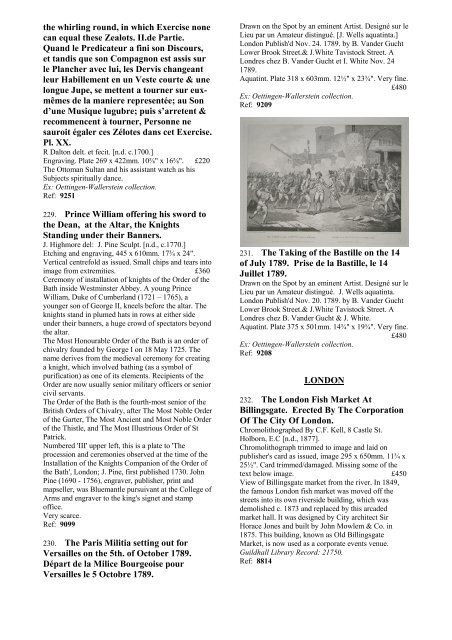

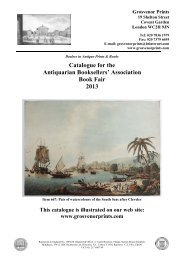
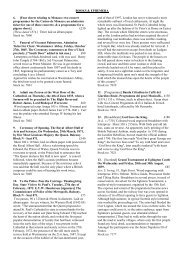
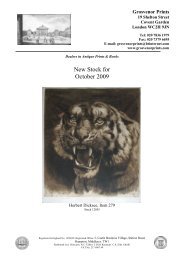
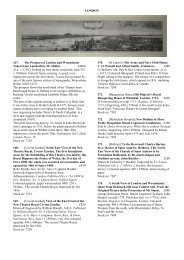
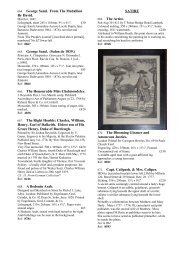
![FOREIGN TOPOGRAPHY 661. [Niagara] The ... - Grosvenor Prints](https://img.yumpu.com/38432042/1/184x260/foreign-topography-661-niagara-the-grosvenor-prints.jpg?quality=85)
